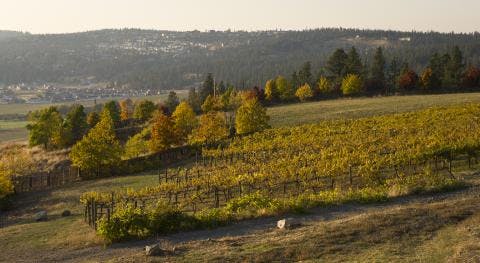Wildfires scarred the West Coast, leaving wine-country scorched but salvageable.

By Nick Baca
Wildfires can burn up a vineyard in moments, but the smoke that blanketed the West Coast is what really devastated this years’ wine season. While red skies damaged grapes in prominent wine growing regions, Washington grape growers and winemakers might be able to help as well as benefit.
Smoke taint is the process in which grapes are flavored by wildfire smoke. This has the potential to destroy potential batches of wine, batches that have been perfected by vintners, said Eric Degerman, CEO of Great Northwest Wines and co-owner of Wine Press Magazine.
“This opens the doors for winemakers in Washington,” Degerman said.
When smoke infiltrates and taints grapes’ skin, it can leave behind a smoky flavor, Degerman said. Grapes and vineyards closest to the flames are at the highest risk of smoke taint.
“I have come across tainted wine before,” Degerman said. “It leaves the wine smelling like an ashtray: the quintessential sign of wildfire smoke.”
This has led some vintners to try ways to extract smoke flavors from wine or repurpose the tainted wine into brandy, Degerman said.
“It’s a witchcraft that I have a hard time wrapping my head around,” Degerman said.
According to Degerman, some producers, usually smaller ones, feel as though a wine is a snapshot of that vintage, the year the wine was made. To protect their reputations, many affected wineries won’t release 2020 wines, Degerman said.
“At this point, it is too early to make any predictions or assumptions regarding how last month's smoke will affect the wine grapes in Washington,” said Steve Warner, president of Washington State Wine Commission. “Any impact would vary, as each region experienced a different level of smoke exposure.”
Amber Leigh Brownson, director of operations at Leader Block Wine Co. and sommelier, remains skeptical of effects seen in Whatcom County.
“Availability of wine hasn't been an issue. Wine is stockpiled, so things around here don’t look too bad,” Brownson said.
But as this year’s batches of California and Oregon pinot noir, chardonnay and pinot grigio grapes are discarded, there is an opportunity to export Washington wines and grapes to areas heavily affected by smoke taint, Degerman said.
Although there is a wine glut, or overproduction of wine, the year of missing vintages gives Washington wineries a chance to rid their stockpiles.
“Seltzers, beers and other spirits have competitively battled with the wine industry which have lowered the amount of wine sales, and that’s global,” Degerman said.
Large-scale wineries have been buying fewer grapes as a result.
But Washington growers may be able to sell their grapes to wineries in Napa or the Willamette Valley who lost their harvests to wildfire smoke. Wineries that have extra product also can sell finished wine to vendors in these states, Degerman said.
“It’s sad,” Degerman said, but “Washington wineries can benefit from catastrophic fires.”
With climate change intensifying wildfires and increasing their frequency, their effects on wineries and vineyards might be just the beginning of a worsening problem, Degerman said.
The Washington State University Department of Viticulture suggests any grape harvester or vintner interested in determining the level of smoke taint in their crops or wine can send samples to IEH Laboratories and Consulting Group.





